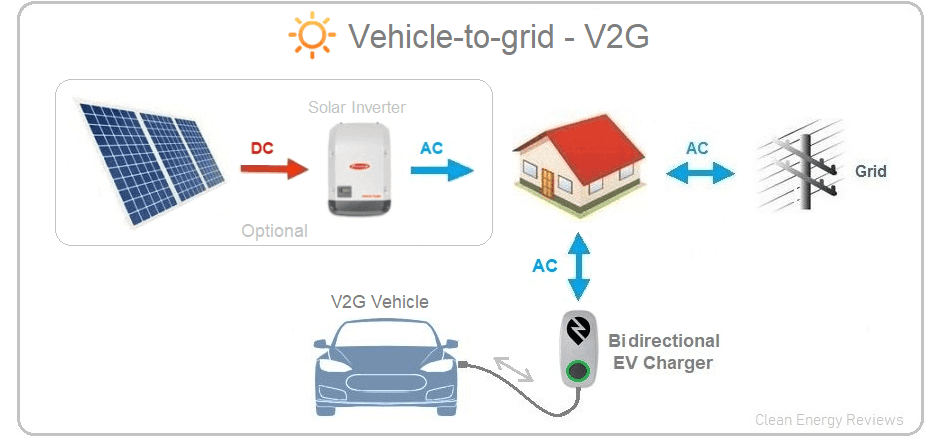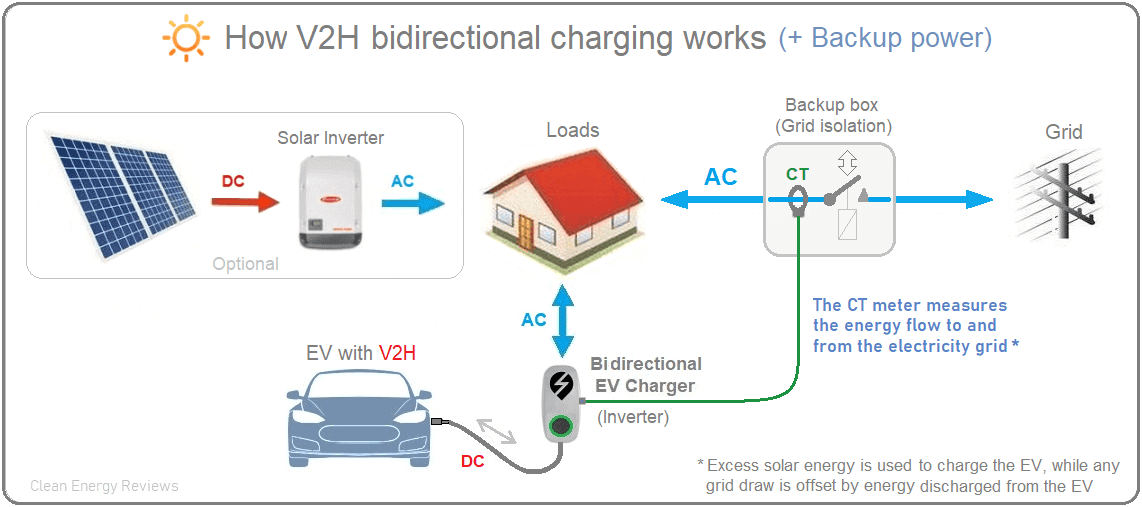What are the uses of bidirectional charging?
Bidirectional chargers can be used for two different applications. The first and most talked about is Vehicle-to-grid or V2G, designed to send or export energy into the electricity grid when the demand is high. If thousands of vehicles with V2G technology are plugged in and enabled, this has the potential to transform how electricity is stored and generated on a massive scale. EVs have large, powerful batteries, so the combined power of thousands of vehicles with V2G could be enormous. Note that V2X is a term that is sometimes used to describe all three variations described below.
Vehicle-to-grid or V2G – EV exports energy to support the electricity grid.
Vehicle-to-home or V2H – EV energy is used to power a home or business.
Vehicle-to-load or V2L * – EV can be used to power appliances or charge other EVs
* V2L does not require a bidirectional charger to operate
The second use of bidirectional EV chargers is for Vehicle-to-home or V2H. As the names suggest, V2H enables an EV to be used like a home battery system to store excess solar energy and power your home. For example, a typical home battery system, such as the Tesla Powerwall, has a capacity of 13.5kWh. In contrast, an average EV has a capacity of 65kWh, equivalent to almost five Tesla Powerwalls. Due to the large battery capacity, a fully charged EV could support an average home for several consecutive days or much longer when combined with rooftop solar.
vehicle-to-grid – V2G
Vehicle-to-grid (V2G) is where a small portion of the stored EV battery energy is exported to the electricity grid when needed, depending on the service arrangement. To participate in V2G programs, a bidirectional DC charger and a compatible EV is required. Of course, there are some financial incentives to do this and EV owners are given credits or reduced electricity costs. EVs with V2G can also enable the owner to participate in a virtual power plant (VPP) program to improve grid stability and supply power during peak demand periods. Only a handful of EVs currently have V2G and bidirectional DC charging capability; these include the later model Nissan Leaf (ZE1) and the Mitsubishi Outlander or Eclipse plug-in hybrids.
Despite the publicity, one of the problems with the roll-out of V2G technology is the regulatory challenges and lack of standard bidirectional charging protocols and connectors. Bidirectional chargers, like solar inverters, are considered another form of power generation and must meet all regulatory safety and shutdown standards in the event of a grid failure. To overcome these complexities, some vehicle manufacturers, such as Ford, have developed simple AC bidirectional charging systems that only operate with Ford EVs to supply power to the home rather than exporting to the grid. Others, such as Nissan, operate using universal bidirectional chargers such as the Wallbox Quasar, described in more detail below. Learn more about the benefits of V2G technology.
Nowadays, most EVs are equipped with the standard CCS DC charge port. Currently, the only EV that uses a CCS port for bidirectional charging is the recently released Ford F-150 Lightning EV. However, more EVs with CCS connection ports will be available with V2H and V2G capability in the near future, with VW announcing its ID electric cars may offer bidirectional charging sometime in 2023.
2. Vehicle to Home – V2H
Vehicle-to-home (V2H) is similar to V2G, but the energy is used locally to power a home instead of being fed into the electricity grid. This enables the EV to function like a regular household battery system to help increase self-sufficiency, especially when combined with rooftop solar. However, the most apparent benefit of V2H is the ability to provide backup power during a blackout.
For V2H to operate, it requires a compatible bidirectional EV charger and additional equipment, including an energy meter (CT meter) installed at the main grid connection point. The CT meter monitors energy flow to and from the grid. When the system detects grid energy consumed by your home, it signals the bidirectional EV charger to discharge an equal amount, thus offsetting any power drawn from the grid. Likewise, when the system detects energy being exported from a rooftop solar array, it diverts this to charge the EV, which is very similar to how smart EV chargers work. To enable backup power in the event of a blackout or emergency, the V2H system must be able to detect the grid outage and isolate it from the network using an automatic contactor (switch). This is known as islanding, and the bidirectional inverter essentially operates as an off-grid inverter using the EV battery. Grid isolation equipment is required to enable backup operation, much like hybrid inverters used in backup battery systems.
Post time: Aug-01-2024

 Portable EV Charger
Portable EV Charger Home EV Wallbox
Home EV Wallbox DC Charger Station
DC Charger Station EV Charging Module
EV Charging Module NACS&CCS1&CCS2
NACS&CCS1&CCS2 EV Accessories
EV Accessories


